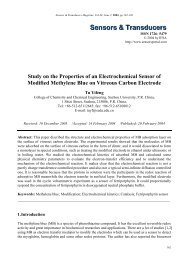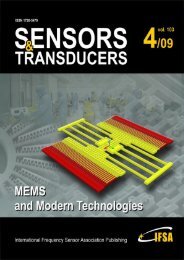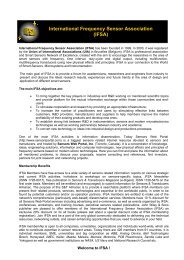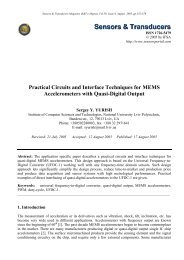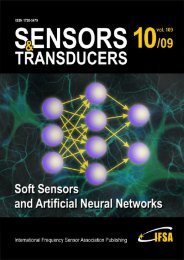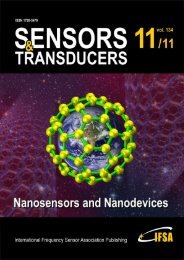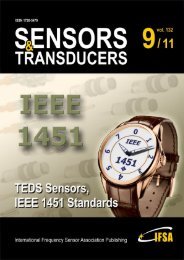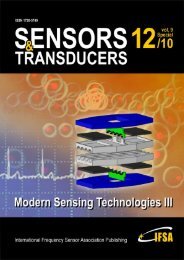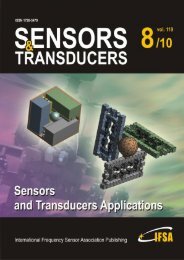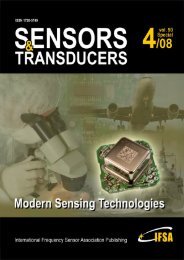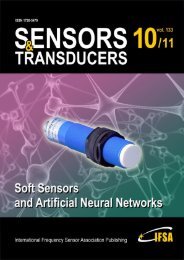Electrical Conduction and Humidity Sensing Properties of NiCr
Electrical Conduction and Humidity Sensing Properties of NiCr
Electrical Conduction and Humidity Sensing Properties of NiCr
You also want an ePaper? Increase the reach of your titles
YUMPU automatically turns print PDFs into web optimized ePapers that Google loves.
Sensors & TransducersVolume 101February 2009www.sensorsportal.com ISSN 1726-5479Editor-in-Chief: pr<strong>of</strong>essor Sergey Y. Yurish, phone: +34 696067716, fax: +34 93 4011989, e-mail: editor@sensorsportal.comEditors for Western EuropeMeijer, Gerard C.M., Delft University <strong>of</strong> Technology, The Netherl<strong>and</strong>sFerrari, Vittorio, Universitá di Brescia, ItalyEditor South AmericaCosta-Felix, Rodrigo, Inmetro, BrazilEditor for Eastern EuropeSachenko, Anatoly, Ternopil State Economic University, UkraineAbdul Rahim, Ruzairi, Universiti Teknologi, MalaysiaAhmad, Mohd Noor, Nothern University <strong>of</strong> Engineering, MalaysiaAnnamalai, Karthigeyan, National Institute <strong>of</strong> Advanced Industrial Science<strong>and</strong> Technology, JapanArcega, Francisco, University <strong>of</strong> Zaragoza, SpainArguel, Philippe, CNRS, FranceAhn, Jae-Pyoung, Korea Institute <strong>of</strong> Science <strong>and</strong> Technology, KoreaArndt, Michael, Robert Bosch GmbH, GermanyAscoli, Giorgio, George Mason University, USAAtalay, Selcuk, Inonu University, TurkeyAtghiaee, Ahmad, University <strong>of</strong> Tehran, IranAugutis, Vygantas, Kaunas University <strong>of</strong> Technology, LithuaniaAvachit, Patil Lalch<strong>and</strong>, North Maharashtra University, IndiaAyesh, Aladdin, De Montfort University, UKBahreyni, Behraad, University <strong>of</strong> Manitoba, CanadaBaoxian, Ye, Zhengzhou University, ChinaBarford, Lee, Agilent Laboratories, USABarlingay, Ravindra, RF Arrays Systems, IndiaBasu, Sukumar, Jadavpur University, IndiaBeck, Stephen, University <strong>of</strong> Sheffield, UKBen Bouzid, Sihem, Institut National de Recherche Scientifique, TunisiaBenachaiba, Chellali, Universitaire de Bechar, AlgeriaBinnie, T. David, Napier University, UKBisch<strong>of</strong>f, Gerlinde, Inst. Analytical Chemistry, GermanyBodas, Dhananjay, IMTEK, GermanyBorges Carval, Nuno, Universidade de Aveiro, PortugalBousbia-Salah, Mounir, University <strong>of</strong> Annaba, AlgeriaBouvet, Marcel, CNRS – UPMC, FranceBrudzewski, Kazimierz, Warsaw University <strong>of</strong> Technology, Pol<strong>and</strong>Cai, Chenxin, Nanjing Normal University, ChinaCai, Qingyun, Hunan University, ChinaCampanella, Luigi, University La Sapienza, ItalyCarvalho, Vitor, Minho University, PortugalCecelja, Franjo, Brunel University, London, UKCerda Belmonte, Judith, Imperial College London, UKChakrabarty, Ch<strong>and</strong>an Kumar, Universiti Tenaga Nasional, MalaysiaChakravorty, Dipankar, Association for the Cultivation <strong>of</strong> Science, IndiaChanghai, Ru, Harbin Engineering University, ChinaChaudhari, Gajanan, Shri Shivaji Science College, IndiaChen, Jiming, Zhejiang University, ChinaChen, Rongshun, National Tsing Hua University, TaiwanCheng, Kuo-Sheng, National Cheng Kung University, TaiwanChiang, Jeffrey (Cheng-Ta), Industrial Technol. Research Institute, TaiwanChiriac, Horia, National Institute <strong>of</strong> Research <strong>and</strong> Development, RomaniaChowdhuri, Arijit, University <strong>of</strong> Delhi, IndiaChung, Wen-Yaw, Chung Yuan Christian University, TaiwanCorres, Jesus, Universidad Publica de Navarra, SpainCortes, Camilo A., Universidad Nacional de Colombia, ColombiaCourtois, Christian, Universite de Valenciennes, FranceCusano, Andrea, University <strong>of</strong> Sannio, ItalyD'Amico, Arnaldo, Università di Tor Vergata, ItalyDe Stefano, Luca, Institute for Microelectronics <strong>and</strong> Microsystem, ItalyDeshmukh, Kiran, Shri Shivaji Mahavidyalaya, Barshi, IndiaDickert, Franz L., Vienna University, AustriaDieguez, Angel, University <strong>of</strong> Barcelona, SpainDimitropoulos, Panos, University <strong>of</strong> Thessaly, GreeceDing Jian, Ning, Jiangsu University, ChinaDjordjevich, Alex<strong>and</strong>ar, City University <strong>of</strong> Hong Kong, Hong KongEditorial Advisory BoardEditors for North AmericaDatskos, Panos G., Oak Ridge National Laboratory, USAFabien, J. Josse, Marquette University, USAKatz, Evgeny, Clarkson University, USAEditor for AsiaOhyama, Shinji, Tokyo Institute <strong>of</strong> Technology, JapanEditor for Asia-PacificMukhopadhyay, Subhas, Massey University, New Zeal<strong>and</strong>Donato, Nicola, University <strong>of</strong> Messina, ItalyDonato, Patricio, Universidad de Mar del Plata, ArgentinaDong, Feng, Tianjin University, ChinaDrljaca, Predrag, Instersema Sensoric SA, Switzerl<strong>and</strong>Dubey, Venketesh, Bournemouth University, UKEnderle, Stefan, University <strong>of</strong> Ulm <strong>and</strong> KTB Mechatronics GmbH,GermanyErdem, Gursan K. Arzum, Ege University, TurkeyErkmen, Aydan M., Middle East Technical University, TurkeyEstelle, Patrice, Insa Rennes, FranceEstrada, Horacio, University <strong>of</strong> North Carolina, USAFaiz, Adil, INSA Lyon, FranceFericean, Sorin, Balluff GmbH, GermanyFern<strong>and</strong>es, Joana M., University <strong>of</strong> Porto, PortugalFrancioso, Luca, CNR-IMM Institute for Microelectronics <strong>and</strong>Microsystems, ItalyFrancis, Laurent, University Catholique de Louvain, BelgiumFu, Weiling, South-Western Hospital, Chongqing, ChinaGaura, Elena, Coventry University, UKGeng, Yanfeng, China University <strong>of</strong> Petroleum, ChinaGole, James, Georgia Institute <strong>of</strong> Technology, USAGong, Hao, National University <strong>of</strong> Singapore, SingaporeGonzalez de la Rosa, Juan Jose, University <strong>of</strong> Cadiz, SpainGranel, Annette, Goteborg University, SwedenGraff, Mason, The University <strong>of</strong> Texas at Arlington, USAGuan, Shan, Eastman Kodak, USAGuillet, Bruno, University <strong>of</strong> Caen, FranceGuo, Zhen, New Jersey Institute <strong>of</strong> Technology, USAGupta, Narendra Kumar, Napier University, UKHadjiloucas, Sillas, The University <strong>of</strong> Reading, UKHashsham, Syed, Michigan State University, USAHern<strong>and</strong>ez, Alvaro, University <strong>of</strong> Alcala, SpainHern<strong>and</strong>ez, Wilmar, Universidad Politecnica de Madrid, SpainHomentcovschi, Dorel, SUNY Binghamton, USAHorstman, Tom, U.S. Automation Group, LLC, USAHsiai, Tzung (John), University <strong>of</strong> Southern California, USAHuang, Jeng-Sheng, Chung Yuan Christian University, TaiwanHuang, Star, National Tsing Hua University, TaiwanHuang, Wei, PSG Design Center, USAHui, David, University <strong>of</strong> New Orleans, USAJaffrezic-Renault, Nicole, Ecole Centrale de Lyon, FranceJaime Calvo-Galleg, Jaime, Universidad de Salamanca, SpainJames, Daniel, Griffith University, AustraliaJanting, Jakob, DELTA Danish Electronics, DenmarkJiang, Liudi, University <strong>of</strong> Southampton, UKJiang, Wei, University <strong>of</strong> Virginia, USAJiao, Zheng, Shanghai University, ChinaJohn, Joachim, IMEC, BelgiumKalach, Andrew, Voronezh Institute <strong>of</strong> Ministry <strong>of</strong> Interior, RussiaKang, Moonho, Sunmoon University, Korea SouthKaniusas, Eugenijus, Vienna University <strong>of</strong> Technology, AustriaKatake, Anup, Texas A&M University, USAKausel, Wilfried, University <strong>of</strong> Music, Vienna, AustriaKavasoglu, Nese, Mugla University, TurkeyKe, Cathy, Tyndall National Institute, Irel<strong>and</strong>Khan, Asif, Aligarh Muslim University, Aligarh, IndiaKim, Min Young, Koh Young Technology, Inc., Korea SouthS<strong>and</strong>acci, Serghei, Sensor Technology Ltd., UK
Ko, Sang Choon, Electronics <strong>and</strong> Telecommunications Research Institute,Korea SouthKockar, Hakan, Balikesir University, TurkeyKotulska, Malgorzata, Wroclaw University <strong>of</strong> Technology, Pol<strong>and</strong>Kratz, Henrik, Uppsala University, SwedenKumar, Arun, University <strong>of</strong> South Florida, USAKumar, Subodh, National Physical Laboratory, IndiaKung, Chih-Hsien, Chang-Jung Christian University, TaiwanLacnjevac, Caslav, University <strong>of</strong> Belgrade, SerbiaLay-Ekuakille, Aime, University <strong>of</strong> Lecce, ItalyLee, Jang Myung, Pusan National University, Korea SouthLee, Jun Su, Amkor Technology, Inc. South KoreaLei, Hua, National Starch <strong>and</strong> Chemical Company, USALi, Genxi, Nanjing University, ChinaLi, Hui, Shanghai Jiaotong University, ChinaLi, Xian-Fang, Central South University, ChinaLiang, Yuanchang, University <strong>of</strong> Washington, USALiawruangrath, Saisunee, Chiang Mai University, Thail<strong>and</strong>Liew, Kim Meow, City University <strong>of</strong> Hong Kong, Hong KongLin, Hermann, National Kaohsiung University, TaiwanLin, Paul, Clevel<strong>and</strong> State University, USALinderholm, Pontus, EPFL - Microsystems Laboratory, Switzerl<strong>and</strong>Liu, Aihua, University <strong>of</strong> Oklahoma, USALiu Changgeng, Louisiana State University, USALiu, Cheng-Hsien, National Tsing Hua University, TaiwanLiu, Songqin, Southeast University, ChinaLodeiro, Carlos, Universidade NOVA de Lisboa, PortugalLorenzo, Maria Encarnacio, Universidad Autonoma de Madrid, SpainLukaszewicz, Jerzy Pawel, Nicholas Copernicus University, Pol<strong>and</strong>Ma, Zhanfang, Northeast Normal University, ChinaMajstorovic, Vidosav, University <strong>of</strong> Belgrade, SerbiaMarquez, Alfredo, Centro de Investigacion en Materiales Avanzados,MexicoMatay, Ladislav, Slovak Academy <strong>of</strong> Sciences, SlovakiaMathur, Prafull, National Physical Laboratory, IndiaMaurya, D.K., Institute <strong>of</strong> Materials Research <strong>and</strong> Engineering, SingaporeMekid, Samir, University <strong>of</strong> Manchester, UKMelnyk, Ivan, Photon Control Inc., CanadaMendes, Paulo, University <strong>of</strong> Minho, PortugalMennell, Julie, Northumbria University, UKMi, Bin, Boston Scientific Corporation, USAMinas, Graca, University <strong>of</strong> Minho, PortugalMoghavvemi, Mahmoud, University <strong>of</strong> Malaya, MalaysiaMohammadi, Mohammad-Reza, University <strong>of</strong> Cambridge, UKMolina Flores, Esteban, Benemérita Universidad Autónoma de Puebla,MexicoMoradi, Majid, University <strong>of</strong> Kerman, IranMorello, Rosario, DIMET, University "Mediterranea" <strong>of</strong> Reggio Calabria,ItalyMounir, Ben Ali, University <strong>of</strong> Sousse, TunisiaMulla, Imtiaz Sirajuddin, National Chemical Laboratory, Pune, IndiaNeelamegam, Periasamy, Sastra Deemed University, IndiaNeshkova, Milka, Bulgarian Academy <strong>of</strong> Sciences, BulgariaOberhammer, Joachim, Royal Institute <strong>of</strong> Technology, SwedenOuld Lahoucine, Cherif, University <strong>of</strong> Guelma, AlgeriaPamidighanta, Sayanu, Bharat Electronics Limited (BEL), IndiaPan, Jisheng, Institute <strong>of</strong> Materials Research & Engineering, SingaporePark, Joon-Shik, Korea Electronics Technology Institute, Korea SouthPenza, Michele, ENEA C.R., ItalyPereira, Jose Miguel, Instituto Politecnico de Setebal, PortugalPetsev, Dimiter, University <strong>of</strong> New Mexico, USAPogacnik, Lea, University <strong>of</strong> Ljubljana, SloveniaPost, Michael, National Research Council, CanadaPrance, Robert, University <strong>of</strong> Sussex, UKPrasad, Ambika, Gulbarga University, IndiaPrateepasen, Asa, Kingmoungut's University <strong>of</strong> Technology, Thail<strong>and</strong>Pullini, Daniele, Centro Ricerche FIAT, ItalyPumera, Martin, National Institute for Materials Science, JapanRadhakrishnan, S. National Chemical Laboratory, Pune, IndiaRajanna, K., Indian Institute <strong>of</strong> Science, IndiaRamadan, Qasem, Institute <strong>of</strong> Microelectronics, SingaporeRao, Basuthkar, Tata Inst. <strong>of</strong> Fundamental Research, IndiaRao<strong>of</strong>, Kosai, Joseph Fourier University <strong>of</strong> Grenoble, FranceReig, C<strong>and</strong>id, University <strong>of</strong> Valencia, SpainRestivo, Maria Teresa, University <strong>of</strong> Porto, PortugalRobert, Michel, University Henri Poincare, FranceRezazadeh, Ghader, Urmia University, IranRoyo, Santiago, Universitat Politecnica de Catalunya, SpainRodriguez, Angel, Universidad Politecnica de Cataluna, SpainRothberg, Steve, Loughborough University, UKSadana, Ajit, University <strong>of</strong> Mississippi, USASadeghian Marnani, Hamed, TU Delft, The Netherl<strong>and</strong>sSapozhnikova, Ksenia, D.I.Mendeleyev Institute for Metrology, RussiaSaxena, Vibha, Bhbha Atomic Research Centre, Mumbai, IndiaSchneider, John K., Ultra-Scan Corporation, USASeif, Selemani, Alabama A & M University, USASeifter, Achim, Los Alamos National Laboratory, USASengupta, Deepak, Advance Bio-Photonics, IndiaShankar, B. Baliga, General Monitors Transnational, USAShearwood, Christopher, Nanyang Technological University, SingaporeShin, Kyuho, Samsung Advanced Institute <strong>of</strong> Technology, KoreaShmaliy, Yuriy, Kharkiv National University <strong>of</strong> Radio Electronics,UkraineSilva Girao, Pedro, Technical University <strong>of</strong> Lisbon, PortugalSingh, V. R., National Physical Laboratory, IndiaSlomovitz, Daniel, UTE, UruguaySmith, Martin, Open University, UKSoleymanpour, Ahmad, Damghan Basic Science University, IranSomani, Prakash R., Centre for Materials for Electronics Technol., IndiaSrinivas, Talabattula, Indian Institute <strong>of</strong> Science, Bangalore, IndiaSrivastava, Arvind K., Northwestern University, USAStefan-van Staden, Raluca-Ioana, University <strong>of</strong> Pretoria, South AfricaSumriddetchka, Sarun, National Electronics <strong>and</strong> Computer TechnologyCenter, Thail<strong>and</strong>Sun, Chengliang, Polytechnic University, Hong-KongSun, Dongming, Jilin University, ChinaSun, Junhua, Beijing University <strong>of</strong> Aeronautics <strong>and</strong> Astronautics, ChinaSun, Zhiqiang, Central South University, ChinaSuri, C. Raman, Institute <strong>of</strong> Microbial Technology, IndiaSysoev, Victor, Saratov State Technical University, RussiaSzewczyk, Roman, Industrial Research Institute for Automation <strong>and</strong>Measurement, Pol<strong>and</strong>Tan, Ooi Kiang, Nanyang Technological University, Singapore,Tang, Dianping, Southwest University, ChinaTang, Jaw-Luen, National Chung Cheng University, TaiwanTeker, Kasif, Frostburg State University, USAThumbavanam Pad, Kartik, Carnegie Mellon University, USATian, Gui Yun, University <strong>of</strong> Newcastle, UKTsiantos, Vassilios, Technological Educational Institute <strong>of</strong> Kaval, GreeceTsigara, Anna, National Hellenic Research Foundation, GreeceTwomey, Karen, University College Cork, Irel<strong>and</strong>Valente, Antonio, University, Vila Real, - U.T.A.D., PortugalVaseashta, Ashok, Marshall University, USAVazquez, Carmen, Carlos III University in Madrid, SpainVieira, Manuela, Instituto Superior de Engenharia de Lisboa, PortugalVigna, Benedetto, STMicroelectronics, ItalyVrba, Radimir, Brno University <strong>of</strong> Technology, Czech RepublicW<strong>and</strong>elt, Barbara, Technical University <strong>of</strong> Lodz, Pol<strong>and</strong>Wang, Jiangping, Xi'an Shiyou University, ChinaWang, Kedong, Beihang University, ChinaWang, Liang, Advanced Micro Devices, USAWang, Mi, University <strong>of</strong> Leeds, UKWang, Shinn-Fwu, Ching Yun University, TaiwanWang, Wei-Chih, University <strong>of</strong> Washington, USAWang, Wensheng, University <strong>of</strong> Pennsylvania, USAWatson, Steven, Center for NanoSpace Technologies Inc., USAWeiping, Yan, Dalian University <strong>of</strong> Technology, ChinaWells, Stephen, Southern Company Services, USAWolkenberg, Andrzej, Institute <strong>of</strong> Electron Technology, Pol<strong>and</strong>Woods, R. Clive, Louisiana State University, USAWu, DerHo, National Pingtung University <strong>of</strong> Science <strong>and</strong> Technology,TaiwanWu, Zhaoyang, Hunan University, ChinaXiu Tao, Ge, Chuzhou University, ChinaXu, Lisheng, The Chinese University <strong>of</strong> Hong Kong, Hong KongXu, Tao, University <strong>of</strong> California, Irvine, USAYang, Dongfang, National Research Council, CanadaYang, Wuqiang, The University <strong>of</strong> Manchester, UKYmeti, Aurel, University <strong>of</strong> Twente, Netherl<strong>and</strong>Yong Zhao, Northeastern University, ChinaYu, Haihu, Wuhan University <strong>of</strong> Technology, ChinaYuan, Yong, Massey University, New Zeal<strong>and</strong>Yufera Garcia, Alberto, Seville University, SpainZagnoni, Michele, University <strong>of</strong> Southampton, UKZeni, Luigi, Second University <strong>of</strong> Naples, ItalyZhong, Haoxiang, Henan Normal University, ChinaZhang, Minglong, Shanghai University, ChinaZhang, Qintao, University <strong>of</strong> California at Berkeley, USAZhang, Weiping, Shanghai Jiao Tong University, ChinaZhang, Wenming, Shanghai Jiao Tong University, ChinaZhou, Zhi-Gang, Tsinghua University, ChinaZorzano, Luis, Universidad de La Rioja, SpainZourob, Mohammed, University <strong>of</strong> Cambridge, UKSensors & Transducers Journal (ISSN 1726-5479) is a peer review international journal published monthly online by International Frequency Sensor Association (IFSA).Available in electronic <strong>and</strong> CD-ROM. Copyright © 2009 by International Frequency Sensor Association. All rights reserved.
Sensors & Transducers JournalContentsVolume 101Issue 2February 2009www.sensorsportal.com ISSN 1726-5479Research ArticlesPreliminary Characterization <strong>of</strong> a Commercial Chiral Stationary Phase as a Selector forChemical Sensor Applications Using a Quartz Crystal MicrobalanceW. J. Buttner, C-L. Lu, V. Perez-Luna, J. R. Stetter <strong>and</strong> G. K. Webster............................................ 1New Copolymers Containing Charge Carriers for Organic Devices with ITO Films Treatedby UV-Ozone Using High Intensity Discharge LampEmerson Roberto Santos, Fábio Conte Correia, Elvo Calixto Burini Junior, Shu Hui Wang, MarciaAkemi Yamasoe, Pilar Hidalgo, Fern<strong>and</strong>o Josepetti Fonseca, Adnei Melges de Andrade ............... 12Aquaregia <strong>and</strong> Oxygen Plasma Treatments on Fluorinated Tin Oxide for Assembly <strong>of</strong>PLEDs Devices Using OC1C10-PPV as Emissive PolymerEmerson Roberto Santos, Elvo Calixto Burini Junior, Fern<strong>and</strong>o Josepetti Fonseca.......................... 22<strong>Electrical</strong> <strong>Conduction</strong> <strong>and</strong> <strong>Humidity</strong> <strong>Sensing</strong> <strong>Properties</strong> <strong>of</strong> <strong>NiCr</strong> 2 O 4 -ZnO-CeO 2 CompositesL. Regina Mary, K. S. Nagaraja.......................................................................................................... 31<strong>Humidity</strong> <strong>and</strong> <strong>Electrical</strong> <strong>Sensing</strong> <strong>Properties</strong> <strong>of</strong> <strong>NiCr</strong> 2 O 4 –ZnO–MnO 2 CompositesRegina Mary L., Jeyaraj B. <strong>and</strong> Nagaraja K. S................................................................................... 42Poly (3, 4-Ethylenedioxythiophene) - Poly (4-Styrenesulfonate) for <strong>Humidity</strong> <strong>Sensing</strong> UsingInk-jet Printing Technique on Flexible Polyimide SubstrateHee C. Lim, Yew Fong Hor, Yew L. Hor, James L. Zunino III <strong>and</strong> John F. Federici.......................... 52Cobalt Doped SnO 2 Thick Film Gas Sensors: Conductance <strong>and</strong> Gas ResponseCharacteristics for LPG <strong>and</strong> CNG GasV. Kumar, S. K. Srivastava, Kiran Jain............................................................................................... 60Study on Gas <strong>Sensing</strong> Performance <strong>of</strong> TiO 2 Screen Printed Thick FilmsC. G. Dighavkar, A. V. Patil <strong>and</strong> R. Y. Borse...................................................................................... 73Metal Oxides Doped PPY-PVA Blend Thin Films Based Gas SensorD. B. Dupare, M. D. Shirsat <strong>and</strong> A. S. Aswar..................................................................................... 82Surface Morphology Dependent Copper Sulphide Ammonia Gas Sensor Working at RoomTemperature: Effect <strong>of</strong> SHI IrradiationRamphal Sharma, Abhay A. Sagade, J. C. Vyas , P. K. Nema, Anil Ghule <strong>and</strong> Sung-Hwan Han .... 90NO 2 Gas <strong>Sensing</strong> <strong>Properties</strong> <strong>of</strong> Screen Printed ZnO Thick FilmsA. V. Patil, C. G. Dighavkar <strong>and</strong> R. Y. Borse...................................................................................... 96Loss <strong>of</strong> Capacitance Ideality in Label-Free Immuno-ChipS<strong>and</strong>ro Carrara, Vijayender Bhalla, Luca Benini, Bruno Samorì ....................................................... 104Development <strong>of</strong> an Optical Urea Biosensor Using Polypyrrole-polyvinyl Sulphonate FilmH. J. Kharat, K. Datta, P. Ghosh, Mahendra D. Shirsat ..................................................................... 112
Performance Comparison <strong>of</strong> SPR Sensors Based on Chalcogenide <strong>and</strong> Silica Glass PrismsRajan Jha <strong>and</strong> Anuj K. Sharma .......................................................................................................... 123Non-invasive Blood Glucose Quantification Using a Hybrid SensorSundararajan Jayapal, Dr. V. Palanisamy, S<strong>and</strong>eep M<strong>and</strong>yam ........................................................ 132Authors are encouraged to submit article in MS Word (doc) <strong>and</strong> Acrobat (pdf) formats by e-mail: editor@sensorsportal.comPlease visit journal’s webpage with preparation instructions: http://www.sensorsportal.com/HTML/DIGEST/Submition.htmInternational Frequency Sensor Association (IFSA).
Sensors & Transducers Journal, Vol. 101, Issue 2, February 2009, pp. 31-41Sensors & TransducersISSN 1726-5479© 2009 by IFSAhttp://www.sensorsportal.com<strong>Electrical</strong> <strong>Conduction</strong> <strong>and</strong> <strong>Humidity</strong> <strong>Sensing</strong> <strong>Properties</strong><strong>of</strong> <strong>NiCr</strong> 2 O 4 -ZnO-CeO 2 CompositesL. Regina Mary, 1 K. S. NagarajaDepartment <strong>of</strong> Chemistry, Loyola Institute <strong>of</strong> Frontier Energy, Loyola CollegeChennai-600 035, Tamil Nadu, India1 Tel.: +91-44-28178200, fax: +91-44-28175566E-mail: dr.ksnagaraja@gmail.comReceived: 31 December 2008 /Accepted: 20 February 2009 /Published: 28 February 2009Abstract: Nickel chromite spinels <strong>NiCr</strong> 2 O 4 was prepared by mixing nitrates <strong>of</strong> Cr(III) <strong>and</strong> Ni(II)solutions with urea as fuel at 350 o C by combustion method. <strong>NiCr</strong> 2 O 4 -ZnO-CeO 2 (NiCZCe)composites with mole ratios 1:1:1, 2:1:1, 1:2:1, 1:1:2, 1:0:1, 0:1:1 <strong>and</strong> 1:1:0 were prepared <strong>and</strong> theirhumidity sensitivity measurements were studied. The samples were sintered at 950 o C for 6h <strong>and</strong> weresubjected to DC resistance measurements as a function <strong>of</strong> relative humidity in the range <strong>of</strong> 5-98 %.The <strong>NiCr</strong> 2 O 4 -ZnO-CeO 2 112 composite showed a resistance <strong>of</strong> 9.6 x10 9 Ω at RH 5 % <strong>and</strong> 7.5x10 6 Ω atRH 98 % with a humidity sensitivity factor <strong>of</strong> 1273. The 2 mol% Li + doped <strong>NiCr</strong> 2 O 4 -ZnO-CeO 2 112composite showed an enhanced humidity sensitivity factor <strong>of</strong> 8471 with a resistance <strong>of</strong> 3.6x10 9 Ω atRH 5 % <strong>and</strong> 4.2x10 5 Ω at RH 98 %. The response <strong>and</strong> recovery time <strong>of</strong> the highest humidity sensingcomposites were studied. X-ray diffraction, FT-IR spectroscopy, scanning electron microscopicstudies, nitrogen adsorption/desorption isotherm at 77 K <strong>and</strong> thermoelectric power measurements wereemployed to the composites to study the structural phases, vibrational frequencies, surfacemorphology, SBET surface area <strong>of</strong> the composites <strong>and</strong> to find the semiconducting nature <strong>of</strong> the highesthumidity sensing composite. Copyright © 2009 IFSA.Keywords: Ceramics, Composites, X-ray diffraction, Microporous materials, <strong>Electrical</strong>, <strong>Properties</strong>1. Introduction<strong>Humidity</strong> sensors have gained increasing applications in industrial processing <strong>and</strong> environmentalcontrol [1]. For manufacturing highly sophisticated integrated circuits in semiconductor industry,31
Sensors & Transducers Journal, Vol. 101, Issue 2, February 2009, pp. 31-41humidity or moisture levels are constantly monitored in wafer processing. There are many domesticapplications, such as intelligent control <strong>of</strong> the living environment in buildings, cooking control formicrowave ovens, <strong>and</strong> intelligent control <strong>of</strong> laundry etc. In automobile industry, humidity sensors areused in rearwindow defoggers <strong>and</strong> motor assembly lines. In medical field, humidity sensors are used inrespiratory equipment, sterilizers, incubators, pharmaceutical processing, <strong>and</strong> biological products. Inagriculture, humidity sensors are used for green-house air-conditioning, plantation protection (dewprevention), soil moisture monitoring, <strong>and</strong> cereal storage. In general industry, humidity sensors areused for humidity control in chemical gas purification, dryers, ovens, film desiccation, paper <strong>and</strong>textile production, <strong>and</strong> food processing. Oxides with the spinel structure are some <strong>of</strong> the most studiedcompounds in solid-state sciences due to their wide range <strong>of</strong> applications. The structure <strong>of</strong> spinel oxide isresponsible for a variety <strong>of</strong> interesting properties [2-5].In this paper, an investigation <strong>of</strong> electrical <strong>and</strong> humidity sensing properties <strong>of</strong> a triphasic thick filmcomposites <strong>of</strong> <strong>NiCr</strong> 2 O 4 -ZnO-CeO 2 with different mole ratios (1:1:1, 2:1:1, 1:2:1, 1:1:2, 1:0:1, 0:1:1,1:1:0) are presented. From the literature, diphasic oxides in mole ratios or doping oxides in percentagemole ratio has been reported [2, 5]. Triphasic oxides in mole ratios have not been reported so far ashumidity sensors. The variation <strong>of</strong> the DC resistance as a function <strong>of</strong> relative humidity was studied.Thick film in the form <strong>of</strong> pellet is made <strong>of</strong> compressed powder <strong>and</strong> therefore can be considered as acollection <strong>of</strong> tightly packed micro-crystalline grains. When heat-treated or sintered, the grains growtogether into a three-dimensional network <strong>of</strong> semiconductor surfaces, grain boundaries, <strong>and</strong> air-filledpores. In the presence <strong>of</strong> humid air, the conductance <strong>of</strong> the pellet can be altered in a number <strong>of</strong> ways.<strong>Electrical</strong> conductance can occur through internal surface layers <strong>of</strong> adsorbed water [6], the tiny porescan fill with water as determined by the Kelvin equation [7] leading to electrolytic conduction throughbulk water, or the conductance <strong>of</strong> the semiconductor itself can change due to an interaction <strong>of</strong> itssurface energy states with hydroxyl radicals, especially at the grain boundaries [8, 9].2. Experimental Procedure2.1. Sample PreparationAqueous solutions <strong>of</strong> Cr(NO 3 ) 3 .9H 2 O <strong>and</strong> Ni(NO 3 ) 2 .6H 2 O <strong>of</strong> appropriate mole ratio with requiredamount <strong>of</strong> urea as fuel by single-step combustion reaction at 350 o C yielded voluminous nickelchromite (<strong>NiCr</strong> 2 O 4 ) powder [10]. The composites <strong>of</strong> <strong>NiCr</strong> 2 O 4 -ZnO-CeO 2 (NiCZCe) with the moleratios 1:1:1, 2:1:1, 1:2:1, 1:1:2, 1:0:1, 0:1:1, 1:1:0 (Table 1) were prepared by mixing MnCr 2 O 4 , ZnO<strong>and</strong> CeO 2 <strong>and</strong> vibromilling <strong>and</strong> grinding using acetone <strong>and</strong> cetyl alcohol [5,11].Table 1. Sample code, humidity sensitivity factor, energy <strong>of</strong>activation <strong>of</strong> <strong>NiCr</strong> 2 O 4 -ZnO-CeO 2 composites (* 2 mol% Li + doped)CompositescodeNiCZCeR (Ω)RH 5 %R (Ω)RH 98 % S f E a110 3.5 x10 7 1.4 x10 6 24 0.504101 6.6 x10 8 2.7 x10 7 25 0.401011 7.6 x10 9 8.7 x10 8 9 0.483111 4.9 x10 9 5.8 x10 7 84 0.260211 8.4 x10 7 6.7 x10 5 124 0.197121 3.5 x10 10 5.6 x10 8 63 0.280112 9.6 x10 9 7.5 x10 6 1273 0.167*doped 112 3.6 x10 9 4.2 x10 5 8471 0.15032
Sensors & Transducers Journal, Vol. 101, Issue 2, February 2009, pp. 31-41The composite code NiCZCe 111 represents (Table 1) one mole <strong>of</strong> <strong>NiCr</strong> 2 O 4 , one mole <strong>of</strong> ZnO <strong>and</strong> onemole <strong>of</strong> CeO 2 . The resulting mixtures were dried <strong>and</strong> compacted into cylindrical pellets <strong>of</strong> about10mm diameter <strong>and</strong> 5 mm thickness at a pressure <strong>of</strong> 400 MPa. These pellets were sintered at 850 o Cfor 6h in ambient air atmosphere. These pellets were sintered at 850 o C for 6 h in ambient airatmosphere. The heating rate was 10 o C min -1 up to 600 o C. The pellets were kept at 600 o C for 30 minto remove binder. The heating rate from 600 o C to 950 o C was 10 o C min -1 . The samples were cooleddown at room temperature at the natural cooling rate <strong>of</strong> the furnace. Lithium was doped in the basecomposite material by adding 2 mol% LiOH.H 2 O while mixing different mole ratio <strong>of</strong> the oxides. Thesamples were cooled down to room temperature at the natural cooling rate <strong>of</strong> the furnace. As lithiumwas shown to enhance the sensitivity <strong>of</strong> humidity sensors [12] the base matrices were doped with2 mol % <strong>of</strong> LiOH.H 2 O. Since our interest is to prepare a material for humidity sensor, the materialswere used as synthesized.2.2. Characterization <strong>and</strong> <strong>Humidity</strong> <strong>Sensing</strong> StudiesThe DC electrical resistance at different relative humidity levels <strong>of</strong> the samples in the form <strong>of</strong> pelletswas determined by a two-probe method [5, 11] as the present work is to measure the changes insurface conductivity as a function <strong>of</strong> applied field <strong>and</strong> current. The electrical contacts were made onthe surface <strong>of</strong> the pellet by means <strong>of</strong> two thin copper wires affixed with silver paint. Given the highresistivity <strong>of</strong> the materials under investigation, the potential inaccuracy due to contact resistance isassumed negligible. The pellet was inserted in the middle <strong>of</strong> the pyrex tube <strong>of</strong> 5 cm diameter on whichkanthal wire was uniformly wounded externally. The kanthal wire ends were connected to a varian tovary the temperature <strong>and</strong> a copper- constantan thermocouple kept at the pellet was used to measure thetemperature <strong>of</strong> the sample. The electrodes were connected to DC power supply <strong>and</strong> the Keithley6485 picoammeter in series. The temperature dependent conductance experiments in the temperaturerange <strong>of</strong> 120–300 ºC under ambient conditions were carried out to determine the activation energiesfor electrical conduction <strong>of</strong> the samples using the linearized form <strong>of</strong> the expression I = Io exp −Ea/kT ,where I is the current, Ea the activation energy, k the Boltzmann constant <strong>and</strong> T is the temperature.Controlled humidity environments <strong>of</strong> 5, 31, 51, 79 <strong>and</strong> 98 % relative humidity were achieved by usinganhydrous P 2 O 5 , saturated aqueous solution <strong>of</strong> CaCl 2 .6H 2 O, Ca(NO 3 ) 2 .4H 2 O, NH 4 Cl <strong>and</strong> CuSO 4 .5H 2 Oin a closed vessel at an ambient temperature <strong>of</strong> 298 K. Prior to the saturation <strong>of</strong> the pellets in the abovebuffers, the pellets were heat cleaned at 393 K for 12 h to remove adsorbed water. A degassed glasschamber <strong>of</strong> about 200 cm 3 was used for evaluating the response <strong>and</strong> recovery characteristics. Thischamber has a provision for a two-way inlet, one for transpiring the dry air <strong>and</strong> the other for moist airfrom a wet c<strong>and</strong>le. Air drying was accomplished by transpiring the air stream through drying columnspacked with anhydrous CaCl 2 <strong>and</strong> dry P 2 O 5 connected in series. The resistance measurements in thedry air as well as in moist air alternatively helped to establish the response <strong>and</strong> recovery time <strong>of</strong> thecomposites [5].The structural studies were carried out using a Philips X`pert diffractometer for 2values ranging from10 to 80 o using CuK radiation at =1.54 A o . A Perkin-Elmer Infrared spectrometer was used for thedetermination <strong>of</strong> the functional groups. The samples were dispersed in spectroscopic grade KBr pellets<strong>and</strong> were scanned in the range <strong>of</strong> 4000–400 cm -1 .The surface morphology <strong>of</strong> the samples was observed on a JSM-6360 SEM analyzer operating at anaccelerating voltage <strong>of</strong> 15 kV using platinum coated samples. The nitrogen adsorptiondesorptionisotherms <strong>of</strong> the composites were measured using an automatic adsorption instrument. Prior to themeasurements, the composites were degassed at 150 o C overnight. The surface area <strong>of</strong> the compositeswas calculated using BET equation which is the most widely used model for determining the specificsurface area (m 2 g¯1).33
Sensors & Transducers Journal, Vol. 101, Issue 2, February 2009, pp. 31-41The thermoelectric effect (TEP) is a direct conversion <strong>of</strong> thermal differentials into electric voltage <strong>and</strong>vice versa. The TEP measurements were carried between 100 <strong>and</strong> 1000 o C. The thick pellets weres<strong>and</strong>wiched between two circular platinum discs where the sample on either face served as electrodes.The temperature difference between the two ends <strong>of</strong> the sample was measured through two K-typethermocouples <strong>and</strong> EMF generated across the two ends <strong>of</strong> the sample was measured. TEPmeasurements were carried out to underst<strong>and</strong> the nature <strong>of</strong> the charge carriers in the sample using theformula: ,where is the Seebeck coefficient <strong>and</strong> is the thermo EMF produced across the sample due to thetemperature difference. The sign <strong>of</strong> enables to distinguish n- <strong>and</strong> p- type conduction.3. Results <strong>and</strong> Discussion3.1. X-Ray Diffraction StudiesThe powder XRD patterns <strong>of</strong> NiCZCe 112 (Fig. 1) showed the characteristic peaks corresponding to<strong>NiCr</strong> 2 O 4 -ZnO-CeO 2 confirming the absence <strong>of</strong> new phases <strong>and</strong> impurities. The XRD pattern <strong>of</strong> theNiCZCe 112 composite <strong>NiCr</strong> 2 O 4 (JCPDS-896615), ZnO (JCPDS-800075) <strong>and</strong> CeO 2 (JCPDS81-0792). For the 2 mol% Li + NiCZCe 112 composite, the threshold for the detection <strong>of</strong> Li +(~0.04 mass %) lies well below the detection limit <strong>of</strong> XRD (5 mass %) <strong>and</strong> hence the correspondingpeaks are not observed [13].Fig. 1. X-ray diffraction patterns <strong>of</strong> NiCZCe 111, undoped NiCZCe 112 <strong>and</strong> NiCZCe 211 composites.34
Sensors & Transducers Journal, Vol. 101, Issue 2, February 2009, pp. 31-413.2. FT-IR SpectroscopyThe FT-IR spectra <strong>of</strong> NiCZCe 112, NiCZCe 211 composites (Fig. 2) showed spectral b<strong>and</strong>s from400 to 1000 cm –1 belonging to metal oxide stretching vibrations <strong>of</strong> Cr-O, Ni-O, Ce-O <strong>and</strong> Zn-O bonds.The common broadb<strong>and</strong> near 3468 <strong>and</strong> 1654 cm –1 observed were assigned to υ(OH¯)<strong>and</strong> δ(H 2 O)[14,15] for the composites. The broadness <strong>of</strong> the peaks was reduced for chromites [14, 15, 16] <strong>and</strong> thesharp b<strong>and</strong>s around 625 <strong>and</strong> 512 cm -1 are characteristic <strong>of</strong> metal chromite spinels. The FT-IR spectra<strong>of</strong> NiCZCe 112 composite has broader b<strong>and</strong> around 3400 cm -1 <strong>and</strong> 1600 cm -1 indicating moreadsorption capacity for water than that <strong>of</strong> NiCZCe 211.Fig. 2. FT-IR spectra <strong>of</strong> NiCZCe 211 <strong>and</strong> undoped NiCZCe 112 composites.3.3. Scanning Electron Microscopy (SEM)Fig. 3 (a–c) depicts the intergranular porous structure <strong>of</strong> the composite materials qualitatively. In themicrograph <strong>of</strong> NiCZCe 211 composite the size <strong>of</strong> the grains are larger than that <strong>of</strong> the NiCZCe 112.The 2 mol% Li + doped NiCZCe 112 composite showed regular well defined formation <strong>of</strong> grains. Thissuggests that the addition <strong>of</strong> 2 mol% Li + can reduce the grain size with the intergranular pores, leadingto microporosity in addition to the presence <strong>of</strong> mesopores. Furthermore, it is observed for 2 mol% Li +doped NiCZCe 112 composite that the grains connect each other <strong>and</strong>/or aggregate to some extent withwell-developed porosity that is very important to humidity sensing.35
Sensors & Transducers Journal, Vol. 101, Issue 2, February 2009, pp. 31-41(a)(b)(c)Fig. 3. SEM micrographs <strong>of</strong> (a) 2mol% Li + doped NiCZCe 112 (b) undoped NiCZCe 112<strong>and</strong> (c) NiCZCe 211.3.4. Nitrogen Adsorption/Desorption StudiesNitrogen adsorption/desorption isotherms (at 77 K) <strong>of</strong> the 2 mol% Li + doped <strong>and</strong> undopedNiCZCe 112 composites which possessed maximum sensitivity were studied. The BET surface areafor similar type <strong>of</strong> chromites <strong>and</strong> for composites has already been reported by Manoharan et al [10]<strong>and</strong> Saha et al [17]. The isotherms <strong>of</strong> 2 mol% Li + doped <strong>and</strong> undoped NiCZCe 112 composites showeda hysteresis effect with the slope <strong>of</strong> the plateau increasing with a significant increase in the nitrogenuptake through the entire pressure range. The increase in uptake <strong>of</strong> nitrogen in the samples is a result<strong>of</strong> the major increase in porosity created within the 2 mol% Li + doped <strong>and</strong> undoped NiCZCe 112composites. The 2 mol% Li + doped NiCZCe 112 composite exhibited the most prominent hysteresiseffect, which can be characterized by the formation <strong>of</strong> intergranular pores as a result <strong>of</strong> Li + addition.The amount <strong>of</strong> nitrogen adsorbed increased corresponding to the BET surface area <strong>of</strong> 56.34 m 2 /g for 2mol% Li + doped NiCZCe 112 composite while it was only 32.47 m 2 /g for undoped NiCZCe 112composite. The addition <strong>of</strong> 2 mol% Li + retards the growth <strong>of</strong> the bulk phase, leading to an increase inthe surface area, an enhancement in the formation <strong>of</strong> a considerable amount <strong>of</strong> micro <strong>and</strong> mesopores.36
Sensors & Transducers Journal, Vol. 101, Issue 2, February 2009, pp. 31-41Fig. 4. Nitrogen adsorption/desorption isotherm <strong>of</strong> (a) 2mol% Li+ doped NiCZCe 112<strong>and</strong> (b) undoped NiCZCe112 composite.3.5. <strong>Humidity</strong> MeasurementsAll the NiCZCe composites showed a decrease in resistance with an increase in %RH, showing thatthe conduction occurred mainly at the grain surface, which was governed by the total water moleculecontent [18]. The resistance changes in porous spinel type oxides with increasing the humidity leveloccur because <strong>of</strong> adsorption <strong>and</strong> capillary condensation <strong>of</strong> water. At low humidity levels,chemisorption takes place, leading to formation <strong>of</strong> two surface hydroxyls with the charge transportoccurring by the hopping mechanism [18], while at high humidity levels, water is physisorbed on thetop <strong>of</strong> the chemisorbed layer.The humidity sensitivity factor for undoped NiCZCe 112 composite is 1273, whose resistance atRH 5 % is 9.6 x10 9 Ω <strong>and</strong> at RH 98 % is 7.5 x10 6 Ω. The undoped NiCZCe 112 composite has a BETsurface area <strong>of</strong> 32.47 m 2 /g. The sintered porous semiconductor has a large internal surface area for theadsorption <strong>of</strong> water vapor. The humidity sensitivity <strong>of</strong> the composites with various molar ratios <strong>of</strong><strong>NiCr</strong> 2 O 4 -ZnO-CeO 2 is shown in Table 1. Thus, the 2 mol% Li + NiCZCe 112 composite possessedcomparatively a high humidity sensitivity factor <strong>of</strong> 8471 has a BET surface area <strong>of</strong> 56.34 m 2 /g with theresistance <strong>of</strong> 3.6 x10 9 Ω at RH 5% <strong>and</strong> 4.2 x10 5 Ω at RH 98%, while that <strong>of</strong> undoped NiCZCe 112 <strong>and</strong>NiCZCe 211 was only 1273 <strong>and</strong> 124, respectively. The higher surface area <strong>of</strong> 2mol% Li +NiCZCe 112 composite is due to the formation <strong>of</strong> micropores along with mesopores in the ceramicbody on sintering at high temperature which is also evident from scanning electron micrographs (seeFig. 2). Decrease in resistance due to Li + doping to metal oxide thick film ceramics have already beenreported [19, 20]. In doped semiconducting oxides the conduction mechanism is due to surfaceconduction at low temperature [21].Usually, the main charge carriers are protons obtained by the dissociation <strong>of</strong> physisorbed watermolecules. The addition <strong>of</strong> alkali cations like Li + that also act as charge carriers along with protonsincreases the conduction. Further the coordination <strong>of</strong> water molecule to Li + increases the acidity <strong>of</strong> thecomposite thereby fast release <strong>of</strong> H + . Good linearity in the log R versus RH% plot is an importantcriterion for good humidity sensitivity material (Fig. 5). The results suggest that the more linear theplot, the better the response, recovery <strong>and</strong> sensitivity <strong>of</strong> the material.37
Sensors & Transducers Journal, Vol. 101, Issue 2, February 2009, pp. 31-41Fig. 5. Plots <strong>of</strong> log R vs. RH% for NiCZCe (a) 011 (b) 111 (c) 101 (d) 110 (e)121(f) undoped 112 (g) 2mol% Li + doped NiCZCe 112 (h) 211 composites.3.6. <strong>Electrical</strong> Conductance StudiesThe room temperature electrical conductance measurements <strong>of</strong> the composites prior to relativehumidity measurements signified that the current increased linearly with the applied voltage,indicating the ohmic contact <strong>of</strong> the electrodes. The temperature dependence <strong>of</strong> electrical conductancecarried out in the temperature range 120–350 ºC suggested that the current (I) increased with anincrease in temperature (T). The activation energies calculated from the temperature dependence <strong>of</strong>conductance data are also shown in Table 1. The activation energy for electrical conduction inpolycrystalline materials generally involves the combination <strong>of</strong> the energy required to raise the carriersfrom the dominant levels to their corresponding transport b<strong>and</strong>s <strong>and</strong> the energy required to create thecarriers in the dominant levels [22]. The low activation energy predicts that the small polaronconduction dominates in the studied temperature range.3.7. Response <strong>and</strong> Recovery CharacteristicsThe response <strong>and</strong> recovery time obtained from the plots <strong>of</strong> log R vs. time (Fig. 6) for undopedNiCZCe 112 composite were found to be 250 s <strong>and</strong> 300 s, respectively, <strong>and</strong> for 2 mol% Li + dopedNiCZCe 112 composite they were found to be 320 s <strong>and</strong> 400 s, respectively. The longer time taken forthe restoration <strong>of</strong> the resistance to that in dry air could be understood in the light <strong>of</strong> the fact that theseexperiments are conducted at 25 °C at which temperature the desorption kinetics is expected to be slowthus evidencing a surface controlled phenomena. The increase in the response <strong>and</strong> recovery time for2 mol% Li + doped NiCZCe 112 compared to that <strong>of</strong> their undoped composites are due to the increasedmicropore formation in the doped composite which results in slow adsorption <strong>and</strong> desorption <strong>of</strong> watermolecules. The 2 mol% Li + doped NiCZCe 112 composite showed increase in response <strong>and</strong> recovery38
Sensors & Transducers Journal, Vol. 101, Issue 2, February 2009, pp. 31-41time showing that the Li + doping enhances porosity in the ceramic material. It was found that the “wet”<strong>and</strong> “dry” run data curves did not exactly match. It was important to be certain that this difference wasa sample hysteresis effect due to differing rates <strong>of</strong> water adsorption <strong>and</strong> desorption from the pelletsurface. Adsorption is an exothermic process, whereas desorption needs external energy for watermolecules to depart from the sample surface [23, 24]. This explains why the recovery time is longerthan the response time.Fig. 6. Response <strong>and</strong> recovery time plots <strong>of</strong> undoped <strong>and</strong> 2 mol% Li + dopedNiCZCe 112 composite.3.8. TEP MeasurementsFrom the TEP measurements, a plot <strong>of</strong> Seebeck coefficient vs. temperature (Fig. 7) gave a negativevalue <strong>of</strong> which implied that the highest humidity sensing undoped NiCZCe 112 composite werewith majority negative charge carriers that are responsible for the conduction. Usually n-type ceramicsare observed to increase humidity sensitivity [25]. This is due to the donation <strong>of</strong> electrons from thechemisorbed water molecules on the ceramic surface.Fig. 7. TEP studies - Plot <strong>of</strong> Seeback coefficient (S) vs. Temperature<strong>of</strong> undoped NiCZCe 112.Conclusion<strong>NiCr</strong> 2 O 4 -ZnO-CeO 2 composites were prepared <strong>and</strong> humidity measurements, FT-IR, BET, SEM, XRD,TEP studies were done. XRD studies confirmed the composite nature <strong>and</strong> the absence <strong>of</strong> the formation<strong>of</strong> new phases. FT-IR study showed the characteristic metal oxide vibrational frequencies. TheNiCZC-112 composite showed the highest humidity sensitivity factor <strong>of</strong> 1.2 x 10 3 . The micropore39
Sensors & Transducers Journal, Vol. 101, Issue 2, February 2009, pp. 31-41formation in the highest humidity sensing composites <strong>of</strong> NiCZCe is evident from nitrogen adsorption<strong>and</strong> desorption <strong>and</strong> SEM studies. Temperature-dependent studies showed the low activation energy <strong>of</strong>all the composites confirming the involvement <strong>of</strong> small polaron hopping mechanism in the conduction.From TEP measurements it is confirmed that the NiCZCe 112 composite has n-type semi-conductingnature. Good response <strong>and</strong> recovery time <strong>of</strong> NiCZCe 112 composite <strong>and</strong> its highest sensitivity conveythat it could be considered as a good commercial humidity sensor.AcknowledgementsThe authors thank the Directorate <strong>of</strong> Collegiate Education (DCE), Tamil Nadu for giving permission<strong>and</strong> the University Grant Commission for the award <strong>of</strong> Faculty Improvement Programme (FIP)carrying out research for two years.References[1]. E. Traversa, Ceramic sensors for humidity detection: the state-<strong>of</strong>-the-art <strong>and</strong> future developments,Sens. Actuators B, 23, 1995, pp. 135-156.[2]. Y. Yokomizo, S. Uno, M. Hirata, H. Hiraki, Microstructure <strong>and</strong> humidity- sensitive properties <strong>of</strong> ZnCr 2 O 4 -LiZnVO 4 ceramics sensors, Sens. Actuators B, 4, 1983, pp. 599-606.[3]. Z. V. Marinkovic et al., Preparation <strong>of</strong> nanostructured Zn-Cr-O spinel powders by ultrasonic spraypyrolysis, J. Euro. Ceram. Soc., 21, 2001, pp. 2051-2055.[4]. T. A. S. Ferreira et al., Structural <strong>and</strong> morphological characterization <strong>of</strong> FeCo 2 O 4 <strong>and</strong> CoFe 2 O 4 spinelsprepared by a coprecipitation method, Solid State Sciences, 5, 2003, pp. 383-392.[5]. S. Pokhrel, B. Jeyaraj, K. S. Nagaraja, <strong>Humidity</strong>-sensing properties <strong>of</strong> ZnCr 2 O 4 -ZnO composites, Mater.Lett., 57, 22-23, 2003, pp. 3543-3548.[6]. J. H. Anderson, G. A. Parks, The electrical conductivity <strong>of</strong> silica gel in the presence <strong>of</strong> adsorbed water,J. Phys. Chem., 72, 1968, pp. 3662-3668.[7]. T. Seiyama, N. Yamazoe, H. Arai, Ceramic humidity sensors, Sens. Actuators B, 4, 1983, pp. 85-96.[8]. S. L. Yang, J. M. Wu, ZrO 2 -TiO 2 ceramic humidity sensors, J. Mater. Sci., 26, 1991, pp. 631-636.[9]. J. L. Zhang, <strong>Electrical</strong> conduction <strong>of</strong> Ba 0.5 Sr 0.5 TiO 3 ceramics under d. c. voltage, J. Mater. Sci. Lett., 11,1992, pp. 294-295.[10]. S. S. Manoharan, C. Patil Kashinath, Combustion synthesis <strong>of</strong> metal Chromite powders, J. Am. Ceram.Soc., 75, 4, 1992, pp. 1012-1015.[11]. S. Pokhrel, K. S. Nagaraja, Solid state electrical conductivity <strong>and</strong> humidity sensing properties <strong>of</strong>Cr 2 O 3 -MoO 3 composites, Phy. Stat. Sol. (A), 194, 2002, pp. 140-146.[12]. M. K. Jain, M. C. Bhatnagar, G. L. Sharma, Effect <strong>of</strong> Li + doping on ZrO 2 -TiO 2 humidity sensor, Sens.Actuators B, 55, 1999, pp. 180-185.[13]. A. M. E. Suresh Raj et al, <strong>Electrical</strong> <strong>and</strong> humidity sensing properties <strong>of</strong> tin(IV)oxide- tin (II) molybdatecomposites, Mater. Res. Bull., 36, 2001, pp. 837-845.[14]. D. Dvoranova, V. Nrezova, M. Mazur, M. A. Malati, Investigations <strong>of</strong> metal doped titanium dioxide photocatalysts, Appl. Catal. B: Environ., 37, 2002, pp. 91-105.[15]. M. F. Zawrah, Investigation <strong>of</strong> lattice constant, sintering <strong>and</strong> properties <strong>of</strong> nano Mg-Al spinels, Mater. Sci.Eng. A, 382, 2004, pp. 362-370.[16]. J. Preudhomme, P. Tarte, Infrared study <strong>of</strong> spinels-III, Spectrochim. Acta, 27A, 1971, pp. 1817-1835.[17]. D. Saha, R. Giri, K. K. Mistry, K. Sengupta, Magnesium chromate-TiO 2 spinel tape cast thick film ashumidity sensor, Sens. Actuators B, 107, 2005, pp. 323-331.[18]. S. Pokhrel, K. S. Nagaraja, <strong>Electrical</strong> <strong>and</strong> humidity sensing properties <strong>of</strong> molybdenum(VI) oxide <strong>and</strong>tungsten (VI) oxide composites, Phy. Stat. Sol., A, 198, 2, 2003, pp. 343-349.[19]. J. Judith Vijaya, L. John Kennedy, G. Sekaran, B. Jeyaraj, K. S. Nagaraja, Effect <strong>of</strong> Sr addition on thehumidity sensing properties <strong>of</strong> CoAl 2 O 4 composites, Sens. Actuators B, 123, 2007, pp. 211-217.[20]. E. Joanni, J. L. Baptista, ZnO-Li 2 O humidity sensors, Sens. Actuators B, 17, 1993, pp. 69-75.[21]. M. L. Zang et al., Fast response <strong>of</strong> undoped <strong>and</strong> Li-doped titania thick films at low temperatures, Sens.Actuators B, 131, 2008, pp. 680-686.40
Sensors & Transducers Journal, Vol. 101, Issue 2, February 2009, pp. 31-41[22]. Z. A. Ansari, T. G. Ko, J. H. Oh, <strong>Humidity</strong> sensing behavior <strong>of</strong> thick films <strong>of</strong> strontium-doped leadzirconium-titanate,Surf. Coat. Technol., 179, 2004, pp. 182-187.[23]. K. Arshaka, K. Twomey, D. Egan, A ceramic thick film humidity Sensor Based on MnZn Ferrite, Sensors,2, 2002, pp. 50-61.[24]. W. Qu, J. U. Meyer, A novel thick-film ceramic humidity sensor, Sens. Actuators B, 40, 1997, pp. 175-182.[25]. K. S. Chou, T. Lee, F. Liu, <strong>Sensing</strong> mechanism <strong>of</strong> a porous ceramic as humidity sensor, Sens. Actuators B,56, 1999, pp. 106-111.___________________2009 Copyright ©, International Frequency Sensor Association (IFSA). All rights reserved.(http://www.sensorsportal.com)41
Sensors & Transducers JournalGuide for ContributorsAims <strong>and</strong> ScopeSensors & Transducers Journal (ISSN 1726-5479) provides an advanced forum for the science <strong>and</strong> technology<strong>of</strong> physical, chemical sensors <strong>and</strong> biosensors. It publishes state-<strong>of</strong>-the-art reviews, regular research <strong>and</strong>application specific papers, short notes, letters to Editor <strong>and</strong> sensors related books reviews as well asacademic, practical <strong>and</strong> commercial information <strong>of</strong> interest to its readership. Because it is an open access, peerreview international journal, papers rapidly published in Sensors & Transducers Journal will receive a very highpublicity. The journal is published monthly as twelve issues per annual by International Frequency Association(IFSA). In additional, some special sponsored <strong>and</strong> conference issues published annually. Sensors &Transducers Journal is indexed <strong>and</strong> abstracted very quickly by Chemical Abstracts, IndexCopernicus JournalsMaster List, Open J-Gate, Google Scholar, etc.Topics CoveredContributions are invited on all aspects <strong>of</strong> research, development <strong>and</strong> application <strong>of</strong> the science <strong>and</strong> technology<strong>of</strong> sensors, transducers <strong>and</strong> sensor instrumentations. Topics include, but are not restricted to:• Physical, chemical <strong>and</strong> biosensors;• Digital, frequency, period, duty-cycle, time interval, PWM, pulse number output sensors <strong>and</strong> transducers;• Theory, principles, effects, design, st<strong>and</strong>ardization <strong>and</strong> modeling;• Smart sensors <strong>and</strong> systems;• Sensor instrumentation;• Virtual instruments;• Sensors interfaces, buses <strong>and</strong> networks;• Signal processing;• Frequency (period, duty-cycle)-to-digital converters, ADC;• Technologies <strong>and</strong> materials;• Nanosensors;• Microsystems;• Applications.Submission <strong>of</strong> papersArticles should be written in English. Authors are invited to submit by e-mail editor@sensorsportal.com 8-14pages article (including abstract, illustrations (color or grayscale), photos <strong>and</strong> references) in both: MS Word(doc) <strong>and</strong> Acrobat (pdf) formats. Detailed preparation instructions, paper example <strong>and</strong> template <strong>of</strong> manuscriptare available from the journal’s webpage: http://www.sensorsportal.com/HTML/DIGEST/Submition.htm Authorsmust follow the instructions strictly when submitting their manuscripts.Advertising InformationAdvertising orders <strong>and</strong> enquires may be sent to sales@sensorsportal.com Please download also our media kit:http://www.sensorsportal.com/DOWNLOADS/Media_Kit_2009.pdf



